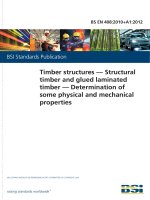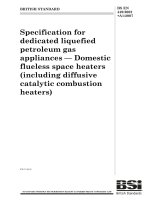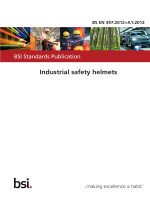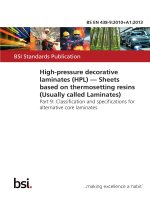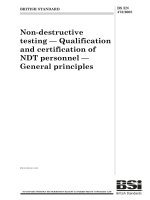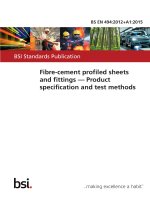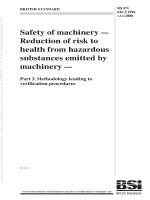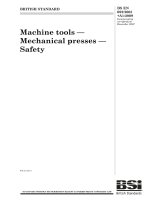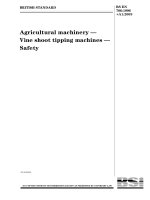Bsi bs en 00589 2008 + a1 2012 (2013)
Bạn đang xem bản rút gọn của tài liệu. Xem và tải ngay bản đầy đủ của tài liệu tại đây (882.49 KB, 20 trang )
BRITISH STANDARD
BS EN 589:2008
589:2008
BS EN 589:2008
+A1:2012
+A1:2012
+A1:2012
Incorporating
corrigendum
August 2013
Automotive fuels —
LPG — Requirements
and test methods
ICS 75.160.20
NO COPYING WITHOUT BSI PERMISSION EXCEPT AS PERMITTED BY COPYRIGHT LAW
BS EN 589:2008+A1:2012
National foreword
This British Standard is the UK implementation of EN 589:2008+A1:2012.
It supersedes BS EN 589:2008 which is withdrawn.
The start and finish of text introduced or altered by amendment is indicated in
the text by tags. Tags indicating changes to CEN text carry the number of the
CEN amendment. For example, text altered by CEN amendment A1 is indicated
by .
The UK participation in its preparation was entrusted to Technical Committee
PTI/15, Natural gas and gas analysis.
A list of organizations represented on this committee can be obtained on
request to its secretary.
The principal differences between this edition of BS EN 589 and the 2004
edition are given in the European Standard foreword.
EN 589 requires that each country implementing it establishes national
annexes detailing requirements for sampling and pump marking, as well as
climate-dependent requirements. These requirements are given in National
annex NA, National annex NB and National annex NC.
The publication does not purport to include all the necessary provisions of a
contract. Users are responsible for its correct application.
Compliance with a British Standard cannot confer immunity from
legal obligations.
This British Standard was
published under the authority
of the Standards Policy and
Strategy Committee
on 30 November 2008
© The British Standards
Institution 2012.
2013.
Published by BSI Standards
Limited 2012.
2013
ISBN 978 0 580 83131
76020 4
7
Amendments/corrigenda issued since publication
Date
Comments
30 April 2012
Implementation of CEN amendment A1:2012
31 August 2013
National annexes NA, NB and NC inserted
EUROPEAN STANDARD
EN 589:2008+A1
NORME EUROPÉENNE
EUROPÄISCHE NORM
March 2012
ICS 75.160.20
English Version
Automotive fuels - LPG - Requirements and test methods
Carburants pour automobiles - GPL - Exigences et
méthodes d'essai
Kraftstoffe für Kraftfahrzeuge - Flüssiggas - Anforderungen
und Prüfverfahren
This European Standard was approved by CEN on 29 June 2008 and includes Amendment 1 approved by CEN on 16 January 2012.
CEN members are bound to comply with the CEN/CENELEC Internal Regulations which stipulate the conditions for giving this European
Standard the status of a national standard without any alteration. Up-to-date lists and bibliographical references concerning such national
standards may be obtained on application to the CEN-CENELEC Management Centre or to any CEN member.
This European Standard exists in three official versions (English, French, German). A version in any other language made by translation
under the responsibility of a CEN member into its own language and notified to the CEN-CENELEC Management Centre has the same
status as the official versions.
CEN members are the national standards bodies of Austria, Belgium, Bulgaria, Croatia, Cyprus, Czech Republic, Denmark, Estonia,
Finland, France, Germany, Greece, Hungary, Iceland, Ireland, Italy, Latvia, Lithuania, Luxembourg, Malta, Netherlands, Norway, Poland,
Portugal, Romania, Slovakia, Slovenia, Spain, Sweden, Switzerland, Turkey and United Kingdom.
EUROPEAN COMMITTEE FOR STANDARDIZATION
COMITÉ EUROPÉEN DE NORMALISATION
EUROPÄISCHES KOMITEE FÜR NORMUNG
Management Centre: Avenue Marnix 17, B-1000 Brussels
© 2012 CEN
All rights of exploitation in any form and by any means reserved
worldwide for CEN national Members.
Ref. No. EN 589:2008+A1:2012: E
BS EN 589:2008+A1:2012
EN 589:2008+A1:2012 (E)
Contents
Page
Foreword ............................................................................................................................................................. 3
1
Scope ...................................................................................................................................................... 4
2
Normative references ............................................................................................................................ 4
3
Terms and definitions ........................................................................................................................... 5
4
Sampling................................................................................................................................................. 5
5
Pump marking ........................................................................................................................................ 5
6
6.1
6.2
6.3
6.4
6.5
Requirements and test methods .......................................................................................................... 5
General ................................................................................................................................................... 5
Water content ......................................................................................................................................... 6
Odour ...................................................................................................................................................... 6
Density .................................................................................................................................................... 7
Precision and dispute ........................................................................................................................... 7
Annex A (normative) Test method for odour of LPG ...................................................................................... 8
A.1
Introduction ............................................................................................................................................ 8
A.2
Principle.................................................................................................................................................. 8
A.3
Material ................................................................................................................................................... 8
A.4
Apparatus ............................................................................................................................................... 8
A.5
Procedure ............................................................................................................................................... 9
A.6
Expression of results ............................................................................................................................ 9
Annex B (normative) Method of calculation of the Motor Octane Number (MON) from
compositional analysis of LPG .......................................................................................................... 10
B.1
Introduction .......................................................................................................................................... 10
B.2
Principle................................................................................................................................................ 10
B.3
Determination ...................................................................................................................................... 10
B.4
Calculation and expression of results .............................................................................................. 10
B.5
Reporting .............................................................................................................................................. 10
Annex C (normative) Absolute vapour pressure blending factors (kPa) .................................................... 12
Annex D (informative) Seasonal gauge vapour pressure limits at 40 °C .................................................... 13
Bibliography ...................................................................................................................................................... 14
2
BS EN 589:2008+A1:2012
EN 589:2008+A1:2012 (E)
Foreword
This document (EN 589:2008+A1:2012) has been prepared by Technical Committee CEN/TC 19
“Petroleum products, lubricants and related products”, the secretariat of which is held by NEN.
This European Standard shall be given the status of a national standard, either by publication of an
identical text or by endorsement, at the latest by September 2012, and conflicting national standards
shall be withdrawn at the latest by September 2012.
Attention is drawn to the possibility that some of the elements of this document may be the subject of
patent rights. CEN [and/or CENELEC] shall not be held responsible for identifying any or all such patent
rights.
This document includes Amendment 1, approved by CEN on 2012-01-16.
This document supersedes !EN 589:2008".
The start and finish of text introduced or altered by amendment is indicated in the text by tags ! ".
Differences between this document and EN 589:2004 include:
introduction of two new test methods for residues replacing the formerly applied EN ISO 13757 [1],
introduction of a revised specification of residue content,
introduction of a new test method for free water detection,
update of the values in Table C.1 in terms of the number of digits.
Next, the Technical Corrigendum on the 2004 edition on Table B.1, as published in 2005, has been
incorporated.
According to the CEN/CENELEC Internal Regulations, the national standards organizations of the
following countries are bound to implement this European Standard: Austria, Belgium, Bulgaria,
Croatia, Cyprus, Czech Republic, Denmark, Estonia, Finland, France, Germany, Greece, Hungary,
Iceland, Ireland, Italy, Latvia, Lithuania, Luxembourg, Malta, Netherlands, Norway, Poland, Portugal,
Romania, Slovakia, Slovenia, Spain, Sweden, Switzerland, Turkey and United Kingdom.
3
BS EN 589:2008+A1:2012
EN 589:2008+A1:2012 (E)
1
Scope
This European Standard specifies requirements and test methods for marketed and delivered automotive
LPG (Liquefied Petroleum Gas). It is applicable to automotive LPG for use in LPG engine vehicles designed
to run on automotive LPG.
NOTE:
For the purposes of this European Standard, the term “% (V/V)” is used to represent the volume fraction.
WARNING - Attention is drawn to the risk of fire and explosion when handling LPG and to the hazard
to health which arises through inhalation of excessive amounts of LPG.
LPG is a highly volatile hydrocarbon liquid which is normally stored under pressure. If the pressure
is released large volumes of gas will be produced which form flammable mixtures with air over the
range of approximately 2 % (V/V) to 10 % (V/V). This European Standard involves the sampling,
handling and testing of LPG. All procedures should be conducted away from sources of ignition
such as naked flames, unprotected electrical equipment and electrostatic hazards. Testing should be
performed as far as practicable under an electrically-safe ventilation hood.
LPG in liquid form can cause cold burns to the skin. Protective clothing such as gloves and goggles
should be worn if contact with the skin is likely to occur.
Unnecessary inhalation of LPG vapour should be avoided. The operator should not be exposed to
3
atmospheres containing more than 1 800 mg/m over an 8 h time-weighted average (TWA) reference
3
period, or more than 2 250 mg/m over a short term, 10 min reference period. One of the tests
described in this European Standard involves the operator inhaling a mixture of air and LPG vapour.
Particular attention is drawn to the cautionary statement provided in A.1, where this method is
referred to.
2
Normative references
The following referenced documents are indispensable for the application of this document. For dated
references, only the edition cited applies. For undated references, the latest edition of the referenced
document (including any amendments) applies.
EN 15469:2007, Petroleum products – Test method for free water in liquefied petroleum gas by visual
inspection
EN 15470:2007, Liquefied petroleum gases – Determination of dissolved residues - High temperature Gas
chromatographic method
EN 15471:2007, Liquefied petroleum gases – Determination of dissolved residues - High temperature
gravimetric method
EN ISO 4256:1998, Liquefied petroleum gases - Determination of gauge vapour pressure - LPG method
(ISO 4256:1996)
EN ISO 4257:2001, Liquefied petroleum gases - Method of sampling (ISO 4257:2001)
EN ISO 4259:2006, Petroleum products - Determination and application of precision data in relation to
methods of test (ISO 4259:2006)
EN ISO 6251:1998, Liquefied petroleum gases - Corrosiveness to copper - Copper strip test
(ISO 6251:1996)
EN ISO 8819:1995, Liquefied petroleum gases - Detection of hydrogen sulfide - Lead acetate method
(ISO 8819:1993)
EN ISO 8973:1999, Liquefied petroleum gases - Calculation method for density and vapour pressure
(ISO 8973:1997)
4
BS EN 589:2008+A1:2012
EN 589:2008+A1:2012 (E)
!deleted text"
EN 27941:1993, Commercial propane and butane - Analysis by gas chromatography (ISO 7941:1988)
ASTM D 3246-05, Standard test method for sulfur in petroleum gas by oxidative microcoulometry
ASTM D 6667-04, Standard test method for determination of total volatile sulfur in gaseous hydrocarbons
and liquefied petroleum gases by ultraviolet fluorescence
3
Terms and definitions
For the purposes of this document, the following terms and definitions apply.
3.1
liquefied petroleum gas (LPG)
petroleum gas that can be stored and/or handled in the liquid phase under moderate conditions of pressure
and at ambient temperature, consisting predominantly of propane, butanes, with small proportions of
propene, butenes and pentanes/pentenes
4
Sampling
Samples shall be taken as described in EN ISO 4257 and/or in accordance with the requirements of national
standards or regulations for the sampling of automotive LPG. The national requirements shall be set out in
detail or shall be referred to by reference in a national annex to this European Standard.
In view of the sensitivity of some of the test methods referred to in this European Standard, particular attention
shall be paid to compliance with any guidance on sampling containers which is included in the test method
standard.
NOTE 1
It is important that the sampling procedure is followed in detail in order to avoid evaporation losses.
NOTE 2
Before sampling from the dispenser hose, 20 l of product should be pumped or recirculated, in order to
obtain a representative sample.
5
Pump marking
Information to be marked on dispensing pumps used for delivering automotive LPG, and the dimensions of
the mark shall be in accordance with the requirements of national standards or regulations for the marking of
pumps for automotive LPG.
Such requirements shall be set out in detail or shall be referred to by reference in a national annex to this
European Standard.
6
6.1
Requirements and test methods
General
When tested by the methods of test given in Table 1, automotive LPG fuel shall comply with the limiting
requirements specified in that Table.
For the minimum vapour pressure, five grades, A, B, C, D and E are given to allow for seasonal limits to be
set nationally for each period of the year. In a national annex to this European Standard, each country shall
indicate which grade(s) it adopts to achieve a minimum vapour pressure of 150 kPa (gauge) throughout the
entire year and shall detail the date range in which the selected grade applies.
5
BS EN 589:2008+A1:2012
EN 589:2008+A1:2012 (E)
Table 1 — Requirements and test methods
Property
Unit
Limits
Minimum
Motor octane number, MON
Total dienes content
(including 1.3 butadiene)
mg/kg
rating
Evaporation residue
mg/kg
Vapour pressure, gauge,
c
at 40 °C
kPa
Vapour pressure, gauge, min.
d, e
150 kPa at a temperature of:
- for grade A
- for grade B
- for grade C
- for grade D
- for grade E
f
Odour
a
0,5
negative
b
a
(See 2. Normative
references)
Annex B
mole %
Copper strip corrosion
(1 h at 40 °C)
Water content
Maximum
89,0
Hydrogen sulphide
Total sulfur content
(after stenching)
Test method
EN 27941
EN ISO 8819
50
class 1
!deleted text"
ASTM D 3246
ASTM D 6667
EN ISO 6251
60
1 550
°C
- 10
-5
0
+ 10
+ 20
Pass
Unpleasant and distinctive at
20 % LFL
EN 15470
EN 15471
EN ISO 4256
EN ISO 8973 and
Annex C
EN ISO 8973 and
Annex C
EN 15469
See 6.3 and
Annex A
See also 6.5.1.
See also 6.5.2.
c
See also 6.5.3.
d
For the purpose of this standard EN ISO 8973 together with Annex C shall be applied at the indicated
temperatures. For internal routine quality control purposes, the values as given in the informative Annex D may
also be used.
e
See also 6.1.
f
See also 6.2.
b
6.2
Water content
Liquefied petroleum gases for automotive purposes shall not contain free water at 0 ºC and at the saturated
vapour pressure on visual inspection.
NOTE 1
For propane rich mixtures with a minimum of 60 % propane, compliance with EN ISO 13758 [1] equally
satisfies this requirement.
For operational purposes it is allowed to add up to 2 000 mg/kg methanol. No other antifreeze agents shall
be added.
6.3
Odour
When tested in accordance with the procedure described in Annex A, the odour of the gas shall be
characteristic (i.e. distinctive and unpleasant), detectable at a concentration in air of 20 % of the lower
flammability limit.
6
BS EN 589:2008+A1:2012
EN 589:2008+A1:2012 (E)
NOTE
6.4
Unpleasant being subjective, the odour should be a caution and inviting to the user to search for the leak.
Density
If a density report is required, EN ISO 3993 [3] or EN ISO 8973 are recommended.
6.5
Precision and dispute
6.5.1 All test methods referred to in this European Standard include a precision statement. In cases of
dispute, the procedures for resolving the dispute and interpretation of the results based on test method
precision, described in EN ISO 4259, shall be used.
6.5.2 In cases of dispute concerning the total sulfur content, ASTM D 6667 shall be used.
6.5.3 In cases of dispute concerning the vapour pressure, EN ISO 4256 shall be used.
7
BS EN 589:2008+A1:2012
EN 589:2008+A1:2012 (E)
Annex A
(normative)
Test method for odour of LPG
A.1 Introduction
This Annex describes a method for assessing the odour of commercial LPG whatever the odour is due to the
presence of unsaturated hydrocarbons or an odour imparted by the addition of odorants.
WARNING —In order to minimize the exposure of personnel conducting the odour test, it is strongly
recommended that the test should only be performed when it has been ascertained that LPG already
meets the other specification limits detailed in Table 1 of this European Standard. The test involves
the operator inhaling a mixture of LPG vapour and air. There is a risk that the short-term and/or longterm (8 h TWA reference period) occupational exposure limits for substances contained in the LPG
may be exceeded. The operator should consult relevant safety and health regulations and ensure
that exposure during the sampling, handling and testing of LPG does not exceed the prescribed
limits.
As a guide, and provided the LPG being tested complies with the quality requirements listed in
Table 1 of this European Standard, an operator will normally remain within recommended
occupational exposure limits provided inhalation of the LPG/air mixture does not exceed three 10
second periods during each test and not more than two tests per hour are performed in the course of
an 8-hour working day. This guidance only takes account of the operator's exposure whilst
conducting odour tests. Other potential exposures should be assessed in order to estimate total
exposure.
A.2 Principle
A sample of liquid gas is completely vaporized and diluted with purified air so that the mixture contains the gas
at a concentration of 20 % of the lower limit of its flammability in air. The odour of the gaseous mixture is
assessed by at least three observers.
NOTE
The lower limits of flammability in air may be taken as:
- butane 1,9 % (V/V);
- propane 2,4 % (V/V).
A.3 Material
Activated charcoal, particle size 1,18 mm to 1,70 mm, for purifying the air stream.
A.4 Apparatus
The apparatus is shown diagrammatically in Figure A.1 and consists of the parts detailed in A.4.1 to A.4.5.
A.4.1
Air purifying column, consisting of a drying tower of approximately 200 ml capacity.
A.4.2
Flowmeter, such as one operating on the floating element principle, for air; range 5 l/min to 15 l/min.
A.4.3 Flowmeter, such as one operating on the floating element principle, for gas; range 5 ml/min to
150 ml/min.
A.4.4
8
Gas mixing bulb, 30 mm in diameter with a jet 4 mm in diameter.
BS EN 589:2008+A1:2012
EN 589:2008+A1:2012 (E)
A.4.5
Glass funnel, diameter 75 mm.
Key
1
2
3
∅ 75 Glass funnel
Mixing bulb
Air purifying column
4
5
6
Flowmeters
Air
Stenched gas
Figure A.1 — Apparatus for assessing odour of LPG
A.5 Procedure
Pass air through the air purifying column (A.4.1) at the specified rate as measured by the air flowmeter (A.4.2).
The air flow rate for propane shall be 8,5 l/min and that for butane shall be 10,5 l/min.
Place the nose inside the rim of the funnel (A.4.5) and inhale gently; check that the air is odourless.
Pass the stenched gas through the gas flowmeter (A.4.3) at a rate of 40 ml/min. Assess the odour of the gasair mixture using at least three observers.
A.6 Expression of results
If the odour is judged to be distinctive and unpleasant by all observers, the batch, which the sample
represents, shall be reported as complying with EN 589.
9
BS EN 589:2008+A1:2012
EN 589:2008+A1:2012 (E)
Annex B
(normative)
Method of calculation of the Motor Octane Number (MON) from
compositional analysis of LPG
B.1 Introduction
This Annex describes a method for the calculation of the motor octane number from a compositional analysis
of LPG.
B.2 Principle
The composition of a sample of LPG is obtained using gas chromatography. The motor octane number of the
sample is calculated from the partial motor octane factors of the constituents and their concentrations
determined from the analysis.
B.3 Determination
Determine the concentration of each constituent present at a concentration in excess of 0,1 mole percent in the
gas sample, using the method described in EN 27941.
B.4 Calculation and expression of results
B.4.1
Calculate the partial motor octane number for each component in the mixture as follows:
Partial octane number = M x C
(B.1)
where
M
is the motor octane factor of specific component (see Table B.1), in the same units as used for C;
C
is the fraction of specific component in the mixture, either in molar, mass or volume percentage.
NOTE
The factors for motor octane number in Table B.1 are empirical values to be used only in the calculation
procedures described in this Annex.
In cases of dispute the molar factors shall be used.
B.4.2 Add the partial motor octane numbers for all of the components determined and round the sum down
to the nearest 0,1.
B.5 Reporting
Report the total (B.4.2) as the LPG motor octane number of the sample.
10
BS EN 589:2008+A1:2012
EN 589:2008+A1:2012 (E)
Table B.1 — Factors for determining the Motor Octane Number of LPG
Component
Motor octane number factor, M
Molar
Mass
Volume
Propane (+ C2)
95,4
95,9
95,6
Propene
83,9
82,9
83,1
Butane (+ C5)
89,0
88,9
88,9
2-Methylpropane (Isobutane)
97,2
97,1
97,1
Butenes
75,8
76,8
75,7
11
BS EN 589:2008+A1:2012
EN 589:2008+A1:2012 (E)
Annex C
(normative)
Absolute vapour pressure blending factors (kPa)
This Annex describes factors for the calculation of the absolute vapour pressure of liquefied petroleum gas. The
method of calculation as given in EN ISO 8973 shall be used. 1)
Table C.1 — Absolute Vapour Pressure Blending Factors
Component
Absolute Vapour Pressure Blending Factors (kPa)
at Temperature (ºC)
-10
Methane
-5
0
10
20
40
21 334
22 742
24 211
27 333
30 707
38 230
Ethane
1 873
2 128
2 407
3 040
3 781
5 613
Ethylene
3 348
3 737
4 159
5 101
6 184
8 805
Propane
346
405
472
630
826
1 353
Propylene
437
510
591
785
1 024
1 661
Butane
71,26
86,64
104,5
149,2
207,6
376,9
Isobutane
109,9
132,3
158,1
221,4
302,7
531
1-Butene
87,91
106,8
128,8
183,4
254,4
457
Isobutene
90,17
109,5
131,9
187,6
259,9
466
Cis-2-Butene
59,63
73,11
88,94
126,7
181,5
336,5
Trans-2-Butene
67,13
81,90
99,16
142,3
199,1
364,8
1,2-Butadiene
43,65
54,08
66,49
98,26
141,3
272,2
1,3-Butadiene
81,55
99,45
120,3
172,2
240,2
436
Pentane
15,23
19,41
24,48
37,85
56,53
115,5
Isopentane
21,98
27,68
34,52
52,25
76,57
151,3
1-Pentene
19,75
25,00
31,33
47,85
70,67
141,5
1) Source of data: the vapour pressure blending factors of components present in liquefied petroleum gas, as indicated
in the table, are primarily calculated using so-called Antoine coefficients as published in [4].
12
BS EN 589:2008+A1:2012
EN 589:2008+A1:2012 (E)
Annex D
(informative)
Seasonal gauge vapour pressure limits at 40 °C
Table D.1 — Seasonal gauge vapour pressure limits at 40 °C
Grade
Minimuma
(kPa)
Equivalent to 150 kPa at
(°C)
A
950
-10
B
800
-5
C
700
0
D
500
+ 10
E
275
+ 20
a
These vapour pressures are calculated using the values given in EN ISO 8973 and are for
internal routine quality control purposes only.
13
BS EN 589:2008+A1:2012
EN 589:2008+A1:2012 (E)
Bibliography
[1]
EN ISO 13757:1996, Liquefied petroleum gases - Determination of oily residues - High-temperature
method (ISO 13757:1996)
[2]
EN ISO 13758:1996, Liquefied petroleum gases - Assessment of the dryness of propane - Valve
freeze method (ISO 13758:1996)
[3]
EN ISO 3993:1995, Liquefied petroleum gas and light hydrocarbons - Determination of density or
relative density - Pressure hydrometer method (ISO 3993:1984)
[4]
The Properties of Gases and Liquids, REID, R.C., PAUSNITZ, J.M. and SHERWOOD,T.K., 3 ed.,
1977
14
rd
BS EN 589:2004
BS
BS EN
EN 589:2004
589:2004
BS EN 589:2008+A1:2012
EN 589:2008+A1:2012 (E)
National annex NA (normative)
National
NA
Sampling
requirements
National annex
annex
NA (normative)
(normative)
Sampling
requirements
Sampling
requirements
NA.1 Introduction
NA.1
Introduction
NA.1national
Introduction
This
annex gives the sampling requirements to comply with Clause 4.
NA.1
Introduction
This
national
annex
gives
the sampling
requirements to
comply with
Clause 4.
This national
national
annex
gives
This
annex
gives the
the sampling
sampling requirements
requirements to
to comply
comply with
with Clause
Clause 4.
4.
NA.2
Normative
references
NA.2
Normative
references
NA.2
Normative
references
The
referenced
documents are indispensable for the application of this national annex. For
NA.2following
Normative
references
The
following
referenced
documents
indispensable
application
of
this
national
annex.
For
undated
references,
the
latest
edition
of the
referenced
document
(including
any
amendments)
applies.
referenced
document
isare
indispensable
forfor
thethe
application
of this
national
annex.
For
The
documents
are
indispensable
for
the
application
of
national
annex.
For
The following
following
referenced
documents
are
indispensable
for
the
application
of this
this
national
annex.
For
undated
references,
the
latest
edition
of
the
referenced
document
(including
any
amendments)
applies.
references,
the
edition
the
document
any
applies.
undated
(including
any
amendments)
applies.
document
BS 5309-1:1976,
Methods
for sampling
products
— Part (including
1:
Introduction
and general principles.
undated
references,
the latest
latest
edition of
ofchemical
the referenced
referenced
document
(including
any amendments)
amendments)
applies.
BS EN
5309-1:1976,
Methods
for
sampling chemical
products
—for
Part
1:
Introduction
and
principles.
ISO 4257:2001,
BSfor
2000-477:2001
– Methods
of test—
petroleum
and its
Liquefied
5309-1:1976,
1: Sampling
Introduction
and general
general
principles.
BS 5309-3:1976,
Methods
sampling chemical
products
Part
3:
of products.
liquids.
5309-1:1976,
1:
Introduction
and
general
principles.
petroleum
gases.
Method
of
sampling
BS
5309-3:1976,
Methods
for
sampling
chemical
products
—
Part
3:
Sampling
of
liquids.
BS
5309-3:1976,
BS
5309-3:1976,
Methods for
for sampling
sampling chemical
chemical products
products —
— Part
Part 3:
3: Sampling
Sampling of
of liquids.
liquids.
NA.3
Sampling Methods
NA.3
Sampling
NA.3
Sampling
Samples
shall be taken from an appropriate sample point on the storage tank at the retail outlet.
NA.3
Sampling
Samples
shall
be
from
an appropriate
sample
point
on the
storage
tank
at
the retail
outlet.
Samples
shall
be taken
taken
from
appropriate
sample
point
the
storage
tank
at
outlet.
For
all test
methods,
sampling
shall
be carried
out from
theon
liquid
phase intank
accordance
with the
procedures
Samples
shall
be
taken
from an
an
appropriate
sample
point
on
the storage
at the
the retail
retail
outlet.
test
methods,
sampling
shall
be
carried
out
from
the
liquid
phase
in
accordance
with
the
For
all
test
methods,
sampling
shall
be
carried
out
from
the
liquid
phase
in
accordance
with
the
procedures
described
for
liquefied
gases
in
BS
5309-1:1976
and
BS
5309-3:1976,
Section
6,
except
that
all
bombs
used
For
all
test
methods,
sampling
shall
be
carried
out
from
the
liquid
phase
in
accordance
with
the
procedures
For
allbetest
methods,
sampling
shall
beullage
carried
out
from
the liquid phase
in accordance
with
thebombs
procedures
procedures
described
for
liquefied
gases
in
BS
EN
ISO
4257:2001,
BS
2000-477:2001.
described
for
liquefied
gases
in
BS
5309-1:1976
and
BS
5309-3:1976,
Section
6,
except
that
all
used
shall
fitted
with
two
valves
and
an
tube.
described
for
gases
in
BS
and
described
for liquefied
liquefied
gases
in and
BS 5309-1:1976
5309-1:1976
and BS
BS 5309-3:1976,
5309-3:1976, Section
Section 6,
6, except
except that
that all
all bombs
bombs used
used
shall
be
fitted
with
two
valves
an
ullage
tube.
shall
shall be
be fitted
fitted with
with two
two valves
valves and
and an
an ullage
ullage tube.
tube.
National annex NB (normative)
National
annex
NB
Pump
marking
National
annex requirements
NB (normative)
(normative)
Pump
Pump marking
marking requirements
requirements
NB.1 Introduction
NB.1
Introduction
NB.1
Introduction
This national
annex gives the pump marking requirements to comply with Clause 5.
NB.1
Introduction
This
national
annex
This national
national
annex gives
gives the
the pump
pump marking
marking requirements
to comply
requirements to
comply with
with Clause
Clause 5.
5.
This
annex
gives
the
pump
marking
requirements
to
comply
with
Clause
5.
NB.2
Requirements
NB.2
Requirements
NB.2
Requirements
NB.2
Requirements
NB.2.1
Pump marking
NB.2.1
Pump
marking
NB.2.1
Pump
marking
For
the Pump
purposes
of this British Standard the following information shall be marked on each dispensing
NB.2.1
marking
For
the
purposes
this
British
Standard
the
information
shall
be
on
pump
or
container
delivering
automotive
LPG that
conforms
to this
British Standard
into the
For the
the purposes
purposes of
ofused
this for
British
Standard
the following
following
information
shall
be marked
marked
on each
each dispensing
dispensing
For
of
this
British
Standard
the
following
information
shall
be
marked
on
each
dispensing
pump
or
container
used
for
delivering
automotive
LPG
that
conforms
to
this
British
Standard
into the
consuming
vehicle.
pump
or
container
used
for
delivering
automotive
LPG
that
conforms
to
this
British
Standard
pump
or container
used for delivering automotive LPG that conforms to this British Standard into
into the
the
consuming
vehicle.
consuming
vehicle.
a)
The
name
or
mark
of
the
supplier
or
vendor
of
the
automotive
LPG.
consuming vehicle.
a)
The name
or mark
of
the
supplier or
vendor
of
the automotive
LPG.
a)
name
mark
of
the
vendor
of
automotive
b) The mark
shown
NB.1. or
The
this mark shall be as shown in
minimum
a)
name1)or
or
markin
ofFigure
the supplier
supplier
or
vendor
of the
thedimensions
automotiveofLPG.
LPG.
1)(see
b)
The
mark
shown
in
Figure
NB.1.
The
minimum
dimensions
of
this
mark
shall
shown
in
Figure
NB.1
Note
1)
and
the
colour
used
for
and
shall
contrast
the
design
lettering
be be
in as
clear
1)
1) shown
b)
mark
in
Figure
NB.1.
The
this
mark
shall
be
as
shown
in
minimum
dimensions
of
b) The
The
mark
shown
in1)
Figure
NB.1.
The
minimum
dimensions
of
this where
mark
shall
be
as
shown
in
Figure
NB.1
(see
Note
and
the
colour
used
for
the
design
and
lettering
shall
be
in
clear
contrast
The
mark
shall
be
in
a
position
it
can
be
seen
by
the
to
the
background
colour
(see
Note
2).
Figure NB.1
NB.1 (see
(see Note
Note 1)
1) and
and the
the colour
colour used
used for
for the
the design
design and
and lettering
lettering shall
shall be
be in
in clear
clear contrast
contrast
Figure
person
dispensing
fuel.
to
background
colour
Note
Note
minimum dimensions
of the
mark2).
given in Figure NB.1 have been selected to enable its application to pumps of the
to 1the
theThe
background
colour (see
(see
Note
2).
to
the
background
colour
(see
Note
2).
smallest
anticipated
dimensions.
It of
is the
strongly
that,
in have
the interests
of visibility
to the
thetolarger
Note
1 The
minimum
dimensions
markrecommended
given in Figure
NB.1
been selected
to enable
itsmotorist,
application
pumps of the
Note
1
minimum
dimensions
of
the mark
given
NB.1
have been
to
its
application
to pumps
Note
1 The
The
minimum
dimensions
of
mark
given in
in Figure
Figure
NB.1
been selected
selected
to enable
enable
itsmotorist,
application
pumps of
of the
the
recommended
dimensions
be usedItwherever
possible.
smallest
anticipated
dimensions.
is the
strongly
recommended
that,
in have
the interests
of visibility
to the
thetolarger
smallest
anticipated
dimensions.
It
is
strongly
recommended
that,
in
the
interests
of
visibility
to
the
motorist,
the
larger
smallest
anticipated
dimensions.
It
is
strongly
recommended
that,
in
the
interests
of
visibility
to
the
motorist,
the
larger
recommended
dimensions
be
used
wherever
possible.
Note
2 It is recommended
the
background
colour be white.
recommended
dimensions
used
wherever
possible.
recommended
dimensions be
bethat
used
wherever
possible.
Note 2 It is recommended that the background colour be white.
Note
2
It
is
recommended
that
the
background
colour be
be white.
white.
Note 2 It is recommended that the background colour
Marking BS EN 589 on or in relation to a product represents a manufacturer’s declaration of conformity, i.e. a claim by the
product
the
of the standard.
The accuracy
of the claim
is solely the
on
or in meets
relation
torequirements
a product represents
a manufacturer’s
declaration
of conformity,
i.e. claimant’s
a claim by the
on
or
relation
to
a
represents
a
declaration
of
i.e.
a
by
on
or in
in meets
relation
to
abeproduct
product
represents
a manufacturer’s
manufacturer’s
declaration
of conformity,
conformity,
i.e.also
a claim
claim
by the
the
responsibility.
Suchthe
a declaration
is not
torequirements
confused
with
third-party
certification
ofofconformity,
which
be desirable.
manufacturer that
product
the
of the
standard.
The accuracy
the claim
is
solelymay
the
claimant’s
manufacturer
that
the
product
meets
the
requirements
of
the
standard.
The
accuracy
of
the
claim
is
solely
the
claimant’s
manufacturer
that
the
product
meets
the
requirements
of
the
standard.
The
accuracy
of
the
claim
is
solely
the
claimant’s
responsibility. Such a declaration is not to be confused with third-party certification of conformity, which may also be desirable.
responsibility.
responsibility. Such
Such a
a declaration
declaration is
is not
not to
to be
be confused
confused with
with third-party
third-party certification
certification of
of conformity,
conformity, which
which may
may also
also be
be desirable.
desirable.
1)
1)
manufacturer
the
Marking BS that
EN 589
1)
1) Marking
Marking BS
BS EN
EN 589
589
© BSI 28 September 2004
© BSI 28 September 2004
©
© BSI
BSI 28
28 September
September 2004
2004
15
15
15
15
15
BS
EN 589:2004
BS EN 589:2008+A1:2012
EN 589:2008+A1:2012 (E)
Dimensions in millimetres
Auto LPG
a
C
BS EN 589
b
Recommended
Minimum
mm
mm
25
15
100
15
1
12
52
60
a
b
c
Figure NB.1 — Form of marking for automotive LPG
National annex NC (normative)
Climate-dependent requirements
NC.1 Introduction
This national annex gives the climate-dependent requirements to comply with Clause 6.
NC.2 Requirements
For the purposes of this British Standard, the following grades shall apply (see Table 1):
Summer
1 April to 15 October
inclusive
Any of the five grades: grade A, grade B, grade C,
grade D or grade E
NOTE
16
16
Winter
16 October to 31 March
inclusive
Grade A
The date for the change from summer grade to winter grade will be reviewed in the light of experience.
© BSI 28 September 2004
This page has been intentionally left blank
NO COPYING WITHOUT BSI PERMISSION EXCEPT AS PERMITTED BY COPYRIGHT LAW
British Standards Institution (BSI)
BSI is the national body responsible for preparing British Standards and other
standards-related publications, information and services.
BSI is incorporated by Royal Charter. British Standards and other standardization
products are published by BSI Standards Limited.
About us
Revisions
We bring together business, industry, government, consumers, innovators
and others to shape their combined experience and expertise into standards
-based solutions.
Our British Standards and other publications are updated by amendment or revision.
The knowledge embodied in our standards has been carefully assembled in
a dependable format and refined through our open consultation process.
Organizations of all sizes and across all sectors choose standards to help
them achieve their goals.
Information on standards
We can provide you with the knowledge that your organization needs
to succeed. Find out more about British Standards by visiting our website at
bsigroup.com/standards or contacting our Customer Services team or
Knowledge Centre.
Buying standards
You can buy and download PDF versions of BSI publications, including British
and adopted European and international standards, through our website at
bsigroup.com/shop, where hard copies can also be purchased.
If you need international and foreign standards from other Standards Development
Organizations, hard copies can be ordered from our Customer Services team.
Subscriptions
Our range of subscription services are designed to make using standards
easier for you. For further information on our subscription products go to
bsigroup.com/subscriptions.
With British Standards Online (BSOL) you’ll have instant access to over 55,000
British and adopted European and international standards from your desktop.
It’s available 24/7 and is refreshed daily so you’ll always be up to date.
You can keep in touch with standards developments and receive substantial
discounts on the purchase price of standards, both in single copy and subscription
format, by becoming a BSI Subscribing Member.
PLUS is an updating service exclusive to BSI Subscribing Members. You will
automatically receive the latest hard copy of your standards when they’re
revised or replaced.
To find out more about becoming a BSI Subscribing Member and the benefits
of membership, please visit bsigroup.com/shop.
With a Multi-User Network Licence (MUNL) you are able to host standards
publications on your intranet. Licences can cover as few or as many users as you
wish. With updates supplied as soon as they’re available, you can be sure your
documentation is current. For further information, email
BSI Group Headquarters
389 Chiswick High Road London W4 4AL UK
We continually improve the quality of our products and services to benefit your
business. If you find an inaccuracy or ambiguity within a British Standard or other
BSI publication please inform the Knowledge Centre.
Copyright
All the data, software and documentation set out in all British Standards and
other BSI publications are the property of and copyrighted by BSI, or some person
or entity that owns copyright in the information used (such as the international
standardization bodies) and has formally licensed such information to BSI for
commercial publication and use. Except as permitted under the Copyright, Designs
and Patents Act 1988 no extract may be reproduced, stored in a retrieval system
or transmitted in any form or by any means – electronic, photocopying, recording
or otherwise – without prior written permission from BSI. Details and advice can
be obtained from the Copyright & Licensing Department.
Useful Contacts:
Customer Services
Tel: +44 845 086 9001
Email (orders):
Email (enquiries):
Subscriptions
Tel: +44 845 086 9001
Email:
Knowledge Centre
Tel: +44 20 8996 7004
Email:
Copyright & Licensing
Tel: +44 20 8996 7070
Email:
